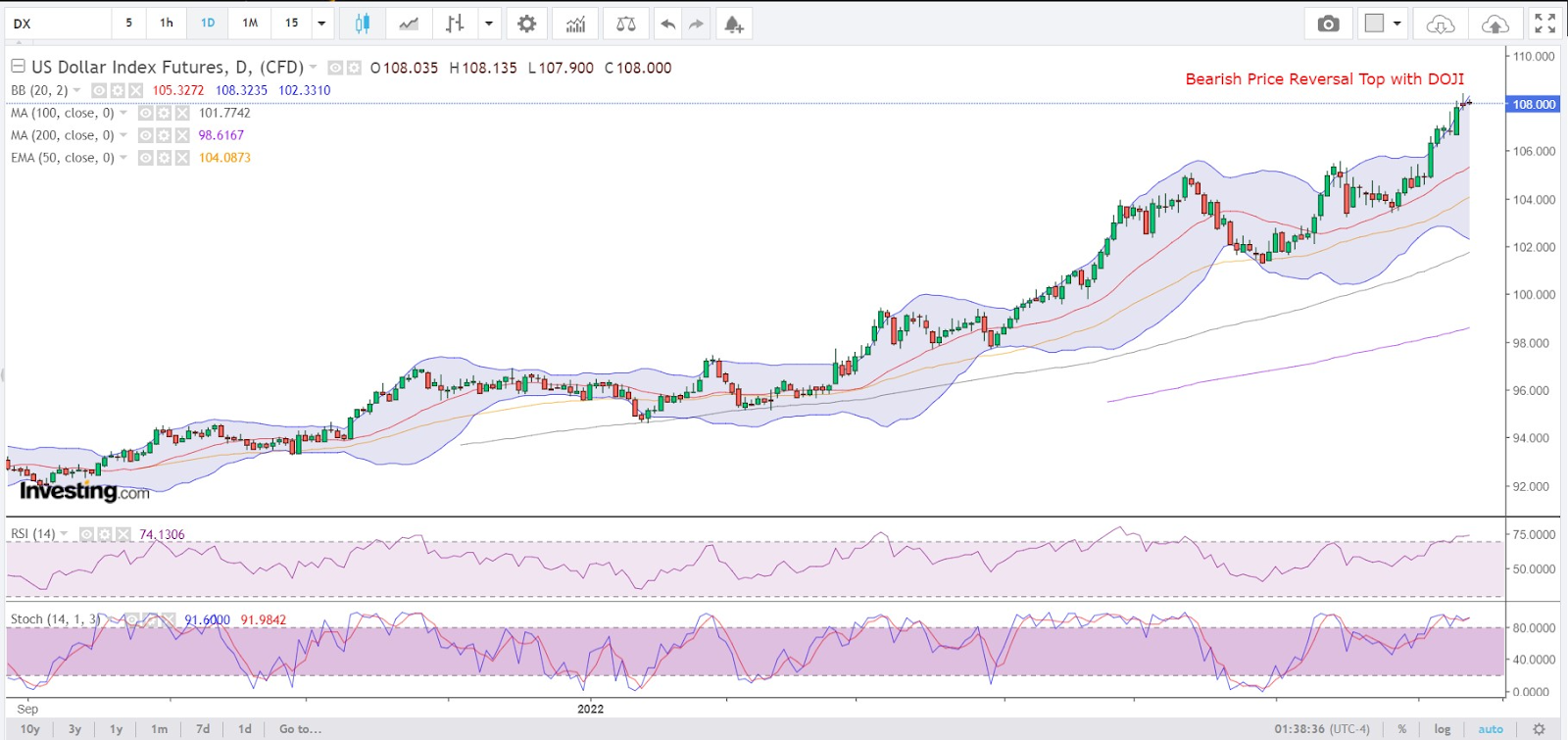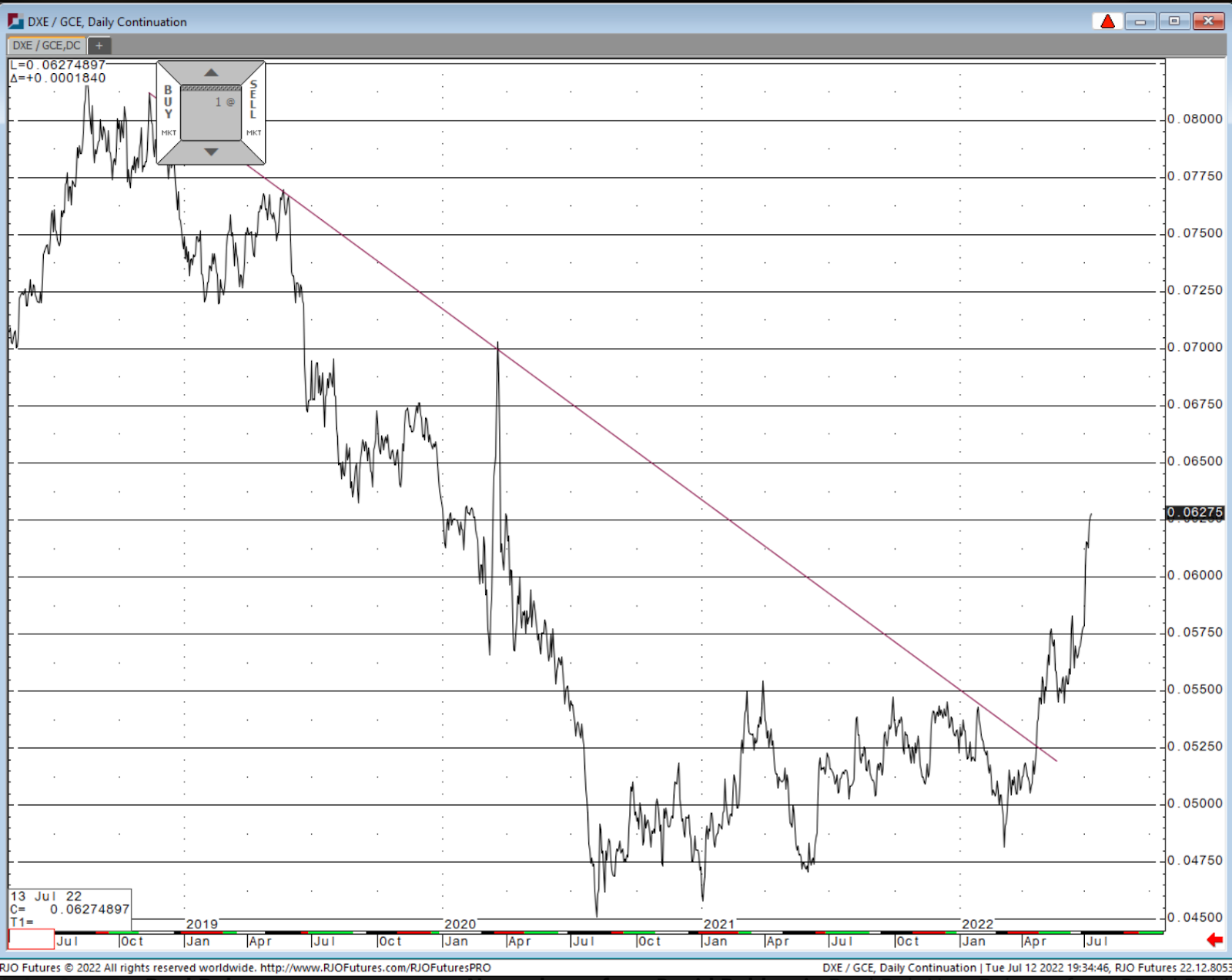- Dollar's 16% bull run over the past year is “about as extreme as it gets, historically speaking,” according to analysts
- Oil falls into a bear market, sliding 21% from June high
- Gold concedes safe-haven crown to the dollar after a 6% drop in the year
- Fed rate hikes could keep the dollar going amid rampant inflation expectations
Oil has tumbled 21% from its June peak, hovering in a bear market, while gold lost 8% in the second quarter for its worst quarter in five. While various macroeconomic and demand-related factors are important for the declines, the two-decade high in the dollar is undoubtedly the most crucial factor.
King Dollar has just been going and going, reaching parity with the euro for the first time in 20 years. Unless it comes to exhaustion on its own, there seems to be no way to stop the rally, not with headlines by the hour about rampant inflation and one hawkish Federal Reserve rate hike estimate after another.
The June reading for the US Consumer Price Index will be upon us today, with estimates suggesting a 1.1% growth on the month (versus 1% in May) and 8.8% on the year (versus 8.6% in May 2021).
Whatever the numbers, the Fed will be ready to respond with the likely hike of another 75 basis points that will bring rates to a top of 2.5% from just 0.25% in February.
A team of Morgan Stanley analysts led by Michael Wilson wrote in a note Monday to clients of the firm:
“Ultimately, the Fed wants a meaningful economic slowdown to curtail inflation, and a stronger dollar is part of that cocktail.”
The analysts noted that the dollar’s 16% rally over the past year—and 6% gain from the end of May alone—is “about as extreme as it gets, historically speaking.”
They also said a runaway greenback often leads to “major financial stress in markets, a recession—or both,” given the 30% overseas sales that US companies typically depend on.
The dynamic can never be too good when you’re manufacturing commodities and goods already made pricey by the dollar, then grappling with weak overseas demand—again because of the dollar. Ultimately, US company earnings will suffer, and by that extension, the S&P 500.
Looking at the Dollar Index and charts for US West Texas Intermediate crude and COMEX gold futures, the greenback still has some way to go amid relative weakness in oil and gold.
Chart by skcharting.com with Investing.com data
First off is the DXY chart, which according to plotting by consultancy skcharting.com, suggests an upcoming critical resistance of 109.25 that could be breached if the dollar’s existing momentum holds.
Sunil Kumar Dixit, Chief Technical Strategist at the consultancy, warns:
“Strength above this level can open the door for an undeterred rally towards 112.60 over mid-term.”
The last time DXY reached above 112 was in May 2002. However, Dixit also cautioned that the dollar may have reached a near-term top. “RSI has entered the overbought territory, with a reading of 74,” he said, referring to the Relative Strength Indicator. He added that:
“Tuesday’s high of 108.42 could not hold on DXY. This could lead the index towards a potentially bearish reversal top and a correction to 107.60, with support at 107.07 and 106.68. Consistent dollar selling can cause a drop to 105.56, though I doubt this will be the case.
[...] The 109-112 buffer zone is a broader one that allows the Dollar Index ample space for consolidation over a larger time frame.”
While much of the dollar’s supercharged strength comes from bets related to Fed rate hikes, the greenback has also been drawing investor interest of late for reasons.
First off, is the safe-haven halo circling over the dollar now. Yes, gold may be what typically comes to mind when we speak of the need to hedge against inflation. But the dollar has trumped gold at the game, seizing the safe-haven crown from the precious metal.
Eli Tesfaye, senior market strategist for the precious metal at RJO Futures in Chicago, notes:
“It has to be very disappointing for gold traders to see the dollar stealing the show away from metals.”
 Chart by skcharting.com with Investing.com data
Chart by skcharting.com with Investing.com data
As per skcharting’s plotting, gold’s chart has a daily stochastic reading of 3/3, indicating oversold conditions and a call for a rebound from the lows. If gold follows that call, it could drop first to $1,705 and $1,697, where a short-term rebound could take it towards $1,738-$1,750-$1,770.
However, if upward momentum sustains, the recovery could help gold recapture the $1,800 berth it lost last month and reach $1,815 eventually. Tesfaye added:
“Gold is looking to set the bottom. But the dollar is firm, and the trend is its friend.
[...] One of the long-term charts suggests we can see it a tad over 110.00. Gold will shine again, but the trend suggests it might take a while before that happens.”

Chart by Eli Tesfaye
Other so-called safe-haven currencies aren’t getting the same handshake as the dollar. Japan’s yen hit a 24-year low lately against the dollar while the Swiss franc is up just about 8% this year. The euro, DXY’s biggest rival, is down 12% on the year, in an almost mirror-like inversion.
One reason for the dollar’s outperformance is the relative resilience of the US economy versus the rest of the world’s—despite the growing conviction by the day that the United States is headed for a recession (if it was not already in one). US gross domestic product contracted by 1.6% in the first quarter. If second quarter GDP readings were also negative, the country would already be in recession, albeit technically.
Even so, the US would still be in a better state than the mess Europe is in due to its Russian-induced energy crisis, which makes the European Central Bank’s job of fighting so much worse than the Fed’s. If the Nord Stream 1 pipeline from Russia to Germany, which is closed for routine maintenance, does not restart later this month, Europe would need emergency solutions that could send energy prices spiraling.
Mark Haefele, chief investment officer at UBS Global Wealth Management, said in a recent research note cited by Forbes:
“In the current atmosphere of risk aversion in markets, the US dollar rally is likely to continue in the near term.”

Chart by skcharting.com with Investing.com data
In the case of oil, WTI’s daily chart suggests a deeper if the current bearish momentum holds.
Dixit, a technical strategist Dixit, said, referring respectively to the Simple Moving Average and the Exponential Moving Average:
“WTI has tested the 200-Day SMA of $93.90 and is attempting a test of the 50-Week EMA of $92.70 next.
There may be a short-term rebound towards $102-$105-$108. But if the intense sell-off pushes through the two support levels, doors may be open for the vertical support areas of $85 and $83.”
WTI’s long-term monthly chart shows a noise-free drop guided by the middle Bollinger Band of $78 and the 200-Day Simple Moving Average of $72.
Disclaimer: Barani Krishnan uses a range of views outside his own to bring diversity to his analysis of any market. For neutrality, he sometimes presents contrarian views and market variables. He does not hold positions in the commodities and securities he writes about.
